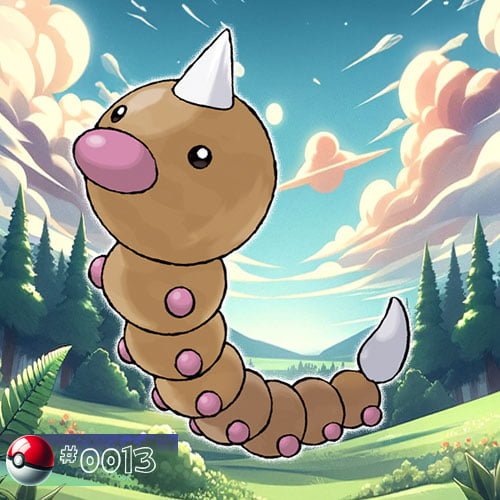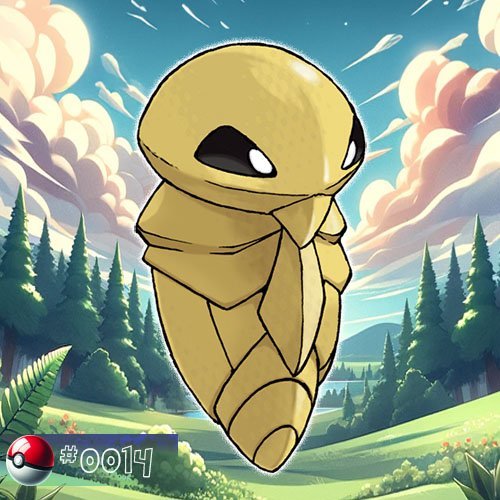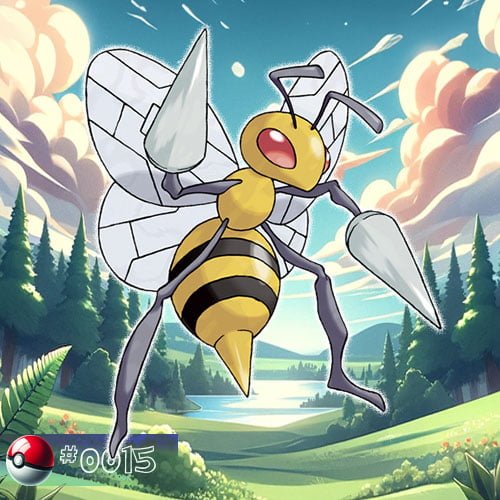Weedle
Weedle is a Bug/Poison type Pokémon often found in forests and grassy areas, and it is known for its rapid evolution into Kakuna and later Beedrill.
Biology
Physical Characteristics
Weedle is a small, insect-like Pokémon characterized by its distinctive physical features. Its segmented body is predominantly brown, adorned with vivid yellow and beige stripes along its abdomen. The body is encased in a hard exoskeleton, offering protection. The head is spherical, housing large, round, red compound eyes without a visible mouth. On top of its head, Weedle sports two short, pointed horns.
Notably, Weedle possesses a conical, sharp-pointed stinger at the rear end of its body. This stinger is a key defensive feature for Weedle. Its feet are small and equipped with suction cups, facilitating easy climbing on vertical surfaces. The overall design of Weedle’s physical characteristics reflects its adaptability to various terrains and its compact, efficient structure.
Weedle’s physical characteristics are tailored for survival in its natural habitat. The suction cups on its feet enable it to cling to tree branches and other surfaces, showcasing its adept climbing abilities. The bright colors and patterns on its exoskeleton serve as a warning to potential predators, signaling the presence of toxic properties.
The lack of a visible mouth suggests that Weedle may feed through its needle-like stinger, possibly extracting nutrients from plants or other sources. Its large, expressive compound eyes hint at heightened sensory perception, allowing Weedle to navigate its surroundings effectively.
Weedle’s segmented body is covered in a hard exoskeleton, providing protection against external threats. Its two prominent stingers on its head can deliver potent toxins to deter predators or adversaries. The spherical shape of Weedle’s body enhances its defensive capabilities, making it challenging for attackers to find vulnerable points.
Weedle’s size and weight make it a lightweight Pokémon, allowing for swift movements and agile maneuvers. The antenna-like structures on its head likely function as sensory organs, aiding Weedle in detecting environmental changes or the presence of other Pokémon.
In conclusion, Weedle’s physical characteristics showcase a combination of defensive adaptations and sensory features, highlighting its survival strategies in the Pokémon world.
Behaviour
Weedle, with its simple and instinct-driven behavior, typically focuses on survival and self-defense. Here are key aspects of Weedle’s behavior.
Weedle’s primary instinct is self-preservation. It uses its stingers to fend off potential threats, injecting venom into attackers or predators.
Weedle is often found in forested areas, where it forages for leaves and other vegetation to eat. Its behavior is influenced by its herbivorous diet.
While Weedle isn’t known for complex social structures, it may engage in simple interactions with other Weedle or Bug-type Pokémon. The nature of these interactions can range from territorial displays to cooperative behaviors.
Weedle likely engages in some form of nest-building behavior, creating a secure space for itself. The specifics of its nesting habits, such as the materials used and the locations chosen, may vary.
Weedle’s behavior is responsive to changes in its environment. Sudden movements or disturbances may trigger defensive reactions, such as retracting its stingers or emitting warning sounds.
As Weedle evolves into Kakuna and later into Beedrill, its behavior undergoes significant transformations. While Weedle is more focused on self-defense, Beedrill, the final evolution, becomes more aggressive and territorial.
Weedle’s behavior centers around survival strategies, basic interactions with its environment, and adaptations that become more pronounced as it evolves.
Evolution
Weedle evolves into Kakuna starting at level 7.
The transformation involves a pupal stage, during which Weedle encases itself in a hard cocoon, signaling a transition into a more advanced form. Weedle’s appearance changes as it becomes Kakuna. The soft, larval features are replaced by the protective shell of the cocoon, reflecting the intermediate stage of its development.
Kakuna evolves into Beedrill starting at level 10.
The metamorphosis from Kakuna to Beedrill signifies the completion of Weedle’s evolutionary journey. The protective cocoon opens to reveal the fully developed and more powerful Beedrill. The transition to Beedrill brings significant physical changes. Kakuna’s hard shell transforms into Beedrill’s sleek, winged body with stingers, reflecting its newfound ability to fly and its more aggressive nature.
Beedrill’s behavior becomes more assertive and territorial compared to Weedle and Kakuna. It gains the ability to use its stingers for offensive purposes and to defend its hive.
Weedle’s evolution into Kakuna and then Beedrill is a crucial aspect of its life cycle, allowing it to adapt to different environmental challenges.
Each stage brings about distinct advantages: Weedle’s mobility and foraging, Kakuna’s protective cocoon, and Beedrill’s heightened combat capabilities.
Appearances
Anime Main Appearances
Weedle, a Bug/Poison-type Pokémon, has made several appearances in the Pokémon anime. Here are some of its major appearances:
”Ash Catches a Pokémon” (Episode 3)
Weedle made its first appearance in the anime in this episode. It was among the Pokémon that Ash encounters in Viridian Forest while on his journey to become a Pokémon Master.
”Challenge of the Samurai” (Episode 4)
Weedle appears in this episode, where Ash faces Samurai, a skilled Pokémon Trainer.
”The Bug Stops Here” (Episode 3 of Pokémon Chronicles)
Weedle is featured in this episode, which focuses on the Bug-type Pokémon residing in the Azalea Gym.
Anime Minor Appearances
These notable appearances highlight Weedle’s versatility in different environments and its role in various aspects of the Pokémon world, from battling to education and research.
A Weedle made an appearance in “The Kangaskhan Kid” and in “The Ultimate Test”. In “Tracey Gets Bugged” a Weedle was among the Bug-type Pokémon on Murcott Island. It also appeared in “Pikachu’s Rescue Adventure” as a wild Pokémon. In “Illusion Confusion!”, a Weedle was part of illusions created by Haunter and Gengar. In “Got Miltank?” a Weedle resided in a Pokémon-exclusive oasis.
In “Talkin’ ‘Bout an Evolution” a Weedle fell ill due to Team Rocket’s experiments. It also appeared in the banned episode ”EP250”’ in a forest outside the Ice Cave. A Weedle featured in “All in a Day’s Wurmple” and “Gonna Rule The School!” where the Pokémon Trainers’ School loaned a Weedle to underage students for lessons. A Weedle appeared in “Destiny Deoxys” and “The Saffron Con” where a Coordinator’s Weedle was stolen by Team Rocket but returned in time to compete in the Saffron City Pokémon Contest in the following episode. Additionally, a Weedle appeared in “The Green Guardian”.
Multiple Weedle appered in ”In the Pink” (as residents of Pinkan Island), ”For Crying Out Loud”, ”In Gettin’ The Bugs Out”, Celebi: The Voice of the Forest”, ”Three Jynx and a Baby!” (two of them), ”For Ho-Oh the Bells Toll!” (as protectors of the Tin Tower), ”Talking a Good Game!” (two of them), ”I Choose You!” and ”The Treasure After the Storm!”.
In “Once More With Reeling!”, a Coordinator’s Weedle competed in the Terracotta Contest. A Weedle was also seen in “Following A Maiden’s Voyage!”, “One Big Happiny Family!”, (healed by Nurse Joy after it was injured) and “Kalos, Where Dreams and Adventures Begin!”. In ”Lumiose City Pursuit!”, ”Mega-Mega Meowth Madness!”, ”Day Three Blockbusters!” and ”Battling With a Clean Slate!”, a Weedle from Professor Sycamore’s lab made appearances.
Weedle were seen in flashbacks in ”Garchomp’s Mega Bond!”, ”An Appetite for Battle!”, “A Watershed Moment!”, “Seeing the Forest for the Trees!” and “Enter Pikachu!”. In “Working My Way Back to Mew!”, Goh captured a Weedle, which has since been seen in subsequent episodes of ”Pokémon Journeys: The Series”.
A Trainer’s Weedle appeared in these episodes:
- ”Mewtwo Strikes Back”
- ”Mewtwo Strikes Back—Evolution”
- ”Caring for a Mystery!”
- ”Trade, Borrow, and Steal!” (one owned by Trainer and another one wild)
- ”Crowning the Chow Crusher!”
Manga Appearances
Magical Pokémon Journey
In the manga “How Do You Do, Pikachu?”, a Weedle makes an appearance, showcasing its presence in the whimsical world of Magical Pokémon Journey.
Pocket Monsters DP
A Weedle is featured in ”Pippi’s Surprising Great Evolution!”, the sixteenth chapter of the Pocket Monsters DP manga (PMDP16), contributing to the diverse Pokémon population in the Pokémon Diamond and Pearl manga series.
Pokémon Adventures – Red, Green & Blue arc
Weedle debuts in “Bulbasaur, Come Home!” as one of the Pokémon that escaped from Professor Oak’s Laboratory, marking its early introduction in the Pokémon Adventures series.
In “Buzz Off, Electabuzz!”, a Weedle is reunited with its Trainer, adding a personal touch to its character development.
“Just a Spearow Carrier” showcases Green catching a Weedle to employ a clever strategy—tricking people into trading more valuable Pokémon during the Pokémon League tournament.
Pokémon Adventures – Gold, Silver & Crystal arc
A Weedle appears in “Murkrow Row” as one of the residents of Gold’s house, emphasizing its role in creating a vibrant and dynamic Pokémon environment.
In “Absolutely Azumarill,” Crystal encounters a Weedle, contributing to the challenges and encounters she faces during her journey.
“The Last Battle XIII” features Weedle as one of the Pokémon participating in the fight in Ilex Forest, adding to the intense battle dynamics.
Pokémon Gold & Silver: The Golden Boys
In “Let’s Fight For The Future!!,” a Trainer’s Weedle takes part in the unfolding events, highlighting its involvement in battles and competitions.
Pokémon Gotta Catch ‘Em All
Multiple appearances in ”Special Chapter – Get Pikachu!”, the fifteenth chapter (GDZ15), ”Beedle the Adventurous, Don’t Let That Typhoon Beat You!” the nineteenth chapter (GDZ19), (where Shu befriends and catches a Weedle), ”Pokémon Hot Springs, Hot-Hot Battle”, the twenty-first chapter (GDZ21), ”Shu’s Christmas”, the twenty-third chapter (GDZ23), and ”Aim for a Big One, the Bug-Catching Contest!”, the 48th chapter of the Pokémon Gotta Catch ‘Em All manga (GDZ48) underscore Weedle’s frequent presence and significance in the Gotta Catch ‘Em All manga series.
Pokémon Journeys: The Series
Goh captures a Weedle in “Battle Frontier Challenge: The Flute Cup!” in Pokémon Journeys: The Series, mirroring his actions in the anime and showcasing Weedle’s continuity across different Pokémon media.
Pokémon Pocket Monsters
Featured in “Big Battle in the Viridian Forest!!,” Weedle participates in a significant battle, showcasing its prowess in Pokémon battles.
Appearing in “Pikachu’s Birthday Party” and “The Hardest Bug Pokémon Wins?!” emphasizes Weedle’s versatility in different storylines and settings within Pokémon Pocket Monsters.
“The Exam Showdown!!” features Weedle in a showdown, adding excitement to the narrative and showcasing its role in various challenges.
Game data
Stats
Location
| Game version | Location |
|---|---|
| Pokémon Red | Routes 2, 24, and 25, Viridian Forest |
| Pokémon Blue | Routes 25, Viridian Forest |
| Pokémon Yellow | Trade |
| Pokémon Gold | National Park (Bug-Catching Contest) |
| Pokémon Silver | Route 2, 26, 27, 30, 31, 34, 35, 36, 37, 38, 39, Azalea Town, Ilex Forest, Lake of Rage, National Park (Bug-Catching Contest) |
| Pokémon Crystal | Routes 2, 24, 25, Route 30, and Route 31, Ilex Forest and National Park (Bug-Catching Contest) |
| Pokémon Ruby and Pokémon Sapphire | Trade |
| Pokémon FireRed and Pokémon LeafGreen | Route 2, 24, 25, Pattern Bush, Viridian Forest |
| Pokémon Emerald | Trade |
| Pokémon Colosseum | Trade |
| Pokémon XD: Gale of Darkness | Trade |
| Pokémon Diamond and Pokémon Pearl | Route 204 |
| Pokémon Platinum | Route 204, Eterna Forest |
| Pokémon HeartGold | National Park (Bug-Catching Contest) |
| Pokémon SoulSilver | Route 2, 30, 31, Ilex Forest, National Park, Viridian Forest |
| Pokémon Black | Breed Kakuna or Beedrill |
| Pokémon White | Trade |
| Pokémon Black 2 | Breed Kakuna or Beedrill |
| Pokémon White 2 | Trade |
| Pokémon X | Route 2, Santalune Forest |
| Pokémon Y | Santalune Forest |
| Pokémon Omega Ruby and Pokémon Alpha Sapphire | Breed Kakuna or Beedrill |
| Pokémon Sun and Pokémon Moon | Trade |
| Pokémon Ultra Sun Pokémon Ultra Moon | Breed Beedrill |
| Pokémon: Let's Go, Pikachu! and Pokémon: Let's Go, Eevee! | Route 2, Viridian Forest |
| Pokémon Sword and Pokémon Shield | Unobtainable |
| Pokémon Brilliant Diamond | Trade |
| Pokémon Shining Pearl | Spacious Cave, Grassland Cave, Swampy Cave, Riverbank Cave, Still-Water Cavern, Sunlit Cavern, Bogsunk Cavern |
| Legends Arceus | Unobtainable |
| Pokémon Scarlet and Pokémon Violet | Unobtainable |
Weedle's origin name
Weedle’s name in various languages reflects its characteristics and appearance.
English: Weedle – The name “Weedle” is likely a combination of “weed” (referring to plants or vegetation) and “needle” (highlighting its pointed stinger or horn).
Japanese: Beedle (ビードル – Bīdoru) – The Japanese name “Beedle” shares similarities with the English name but without the explicit connection to weeds. It still emphasizes the bee-like nature of the Pokémon.
French: Aspicot – The French name “Aspicot” may be derived from “aspic” (a venomous snake) and “cocon” (cocoon), emphasizing the cocoon stage in Weedle’s evolution.
German: Hornliu – The German name “Hornliu” combines “horn” (referring to its horn or stinger) with “Larve” (larva), highlighting its larval form.
Spanish: Weedle – The Spanish name remains consistent with the English name, using “Weedle” to maintain the connection to weeds and the needle-like appendage.
Italian: Weedle – Similar to English and Spanish, the Italian name “Weedle” retains the emphasis on weeds and the stinger.
Korean: 비돌 (Bidol) – The Korean name “Bidol” closely resembles the Japanese name “Beedle” in pronunciation, emphasizing the bee-like characteristics.
Chinese (Mandarin): 獨角蟲 (Dújiǎochóng) – The Mandarin Chinese name “獨角蟲” translates to “single-horned insect,” emphasizing the singular horn or stinger on Weedle.
Weedle’s names across languages generally emphasize its insectoid nature, stinger, and the cocoon stage in its evolutionary line. The variations provide linguistic nuances while maintaining a thematic connection to its characteristics.





